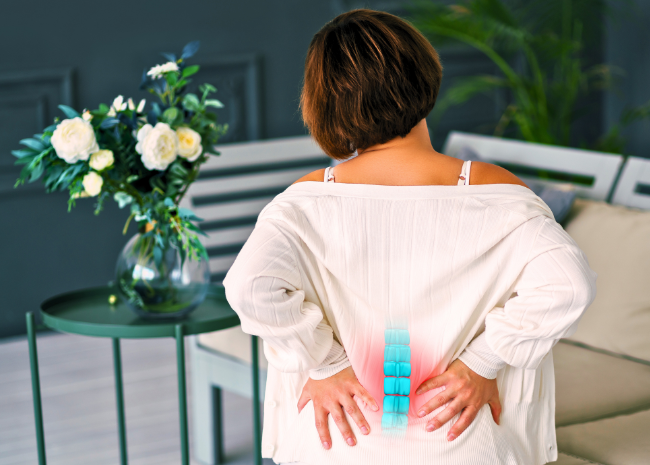
Understanding Degenerative Disc Disease (DDD)
What is Degenerative Disk Disease?
Degenerative disk disease (DDD) is a common cause of back pain that happens when the intervertebral disks in your spine start to break down.
Your spine is comprised of a column of bones called vertebrae, with gel-filled disks between them to absorb shock. Made up of about 80% water, these vertebral disks lose water as you age, causing them to shrink.
This can lead to smaller space between discs, bone spurs, narrowing of the spinal canal, and tears in the annulus, the wrapping on the outside of the intervertebral disc that protects the disk’s soft center.
Symptoms of Degenerative Disk Disease
Not all individuals who have DDD will experience pain, although it is a common complaint. For those who do, the pain can be extreme enough to interfere with simple daily activities.
Pain may start after an injury, or it may begin gradually and become progressively worse.
Common symptoms include:
- Back pain: Persistent or intermittent pain in the lower back that might worsen with movement.
- Neck pain: Pain in the neck that could radiate to the shoulders or arms.
- Numbness and tingling: Sensations in the legs or arms as the condition progresses.
- Muscle weakness: Weakness in muscles due to nerve compression.
Diagnosis
If you’re experiencing symptoms of Degenerative Disc Disease, getting a professional diagnosis is crucial. The diagnosis typically involves:
- Physical examination: A healthcare provider will evaluate your symptoms, medical history, and perform a thorough physical exam.
- Imaging tests: X-rays, MRI scans, or CT scans to get detailed images of the spine and identify disc degeneration.
- Differential diagnosis: It’s important to distinguish DDD from other conditions like herniated discs, spinal stenosis, or osteoarthritis through a comprehensive evaluation.
Treatment Options for Degenerative Disk Disease
Nonsurgical Treatments
Treatments for DDD include surgical and nonsurgical modalities. Usually a last resort, surgery is considered only after attempts at nonsurgical methods do not bring relief.
- Medications: NSAIDs like ibuprofen or naproxen can reduce inflammation and relieve pain. Muscle relaxants or low-dose antidepressants may also be prescribed for chronic pain.
- Physical Therapy: The “gold standard” treatment for Degenerative Disc Disease, physical therapy can help you return to a full activity level again. (More on this later.)
- Other Non-Surgical Interventions: Epidural steroid injections can help reduce inflammation and pain directly at the affected area. Alternative therapies like acupuncture or chiropractic care might also be part of a comprehensive treatment plan.
Other Approaches Include:
- Proper lifting and walking techniques
- Manual therapy to loosen stiff muscles and joints
- Activity modifications to ease your return to movement
- Lifestyle advice and occupational adjustment recommendations
- Pain medication, muscle relaxants, and ice to reduce inflammation
Surgical Treatments
Surgery is usually a last resort and considered only after attempts at nonsurgical methods do not bring relief. It aims to address severe cases where other treatments have not worked.
Physical Therapy For Degenerative Disk Disease
As previously noted, physical therapy is considered the gold treatment for Degenerative Disc Disease.
If you’re struggling with degenerative disk disease (DDD), physical therapy for DDD can offer significant relief and improvement in your quality of life.
Physical therapy for DDD focuses on personalized treatment plans that aim to alleviate pain, enhance mobility, and strengthen the muscles supporting your spine.
What are the best treatment exercises for DDD?
- Stretching and strengthening exercises: To improve flexibility and relieve muscle tension.
- Manual therapy techniques: Such as joint mobilization, soft tissue mobilization, and spinal manipulation to reduce pain and enhance mobility.
- Low-impact aerobic exercise: To boost overall fitness and stamina, reduce the frequency of back pain episodes, and relieve pain intensity.
Through targeted exercises, stretching routines, and manual therapy techniques, physical therapists help reduce inflammation, improve flexibility, and build core stability. This approach not only addresses immediate symptoms but also works to prevent future issues and enhance overall function.
Engaging in physical therapy for DDD can be a highly effective way to manage your condition and regain your daily activities with less discomfort.
If you live in Northern Virginia and are interested in a plan customized to your needs, check out our 18 locations to get started with one of our Physical Therapists today.
Preventing and Managing Degenerative Disk Disease
While you can’t reverse disc degeneration, several lifestyle changes can help manage symptoms and slow progression:
- Maintain a healthy weight: Excess weight puts additional pressure on the spine and accelerates disc degeneration.
- Exercise regularly: Focus on low-impact activities like swimming and walking to strengthen spinal support muscles.
- Adopt proper ergonomics: Use good posture while sitting, standing, and lifting to reduce spinal stress. Supportive furniture and ergonomic equipment can help.
- Be mindful of daily activities: Avoid heavy lifting with improper techniques. Use your legs and core muscles for lifting, keep your back straight, and employ proper protective gear in sports to minimize injury risk.
Conclusion
Degenerative Disk Disease can be very debilitating, more so when it is accompanied by significant pain. Fortunately, physical therapy has excellent outcomes, especially when started at the onset of the condition.
Did you know you have Direct Access* to Physical Therapy? No referral, no problem!
By engaging in an individualized program of exercises that we design, you can experience relief and a full return to activities, mobile and free of pain.

















